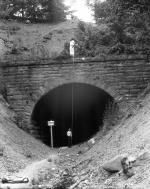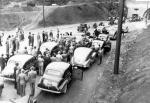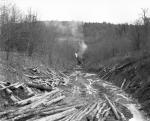![header=[Marker Text] body=[This is one of the original service plazas for the nation's first long-distance superhighway. On October 1, 1940, the Turnpike opened, stretching 160 miles from Irwin to Carlisle. The Turnpike Commission had been created in 1937; construction utilized the old South Pennsylvania Railroad's right-of-way and tunnels. By 1957 the Turnpike spanned 360 miles across the State and extended 110 miles north to Scranton.] sign](http://explorepahistory.com/kora/files/1/10/1-A-1B0-139-ExplorePAHistory-a0b1q5-a_450.gif)
Mouse over for marker text
Name:
Pennsylvania Turnpike
Region:
Laurel Highlands/Southern Alleghenies
County:
Bedford
Marker Location:
South Midway Service Plaza, just east of Turnpike Exit 146, Bedford
Dedication Date:
October 1, 1990
Behind the Marker
By the time Pennsylvania Railroad (PRR) President J. Edgar Thomson died in 1874, the PRR had become the largest railroad in Pennsylvania. A corporate powerhouse whose lines extended west to Chicago, the PRR was also one of the nation's largest and wealthiest economic enterprises. To break its stranglehold on freight that traveled across the state, William H. Vanderbilt of the New York Central Railroad, Franklin B. Gowen of the Philadelphia and Reading Railroad, steel magnate
J. Edgar Thomson died in 1874, the PRR had become the largest railroad in Pennsylvania. A corporate powerhouse whose lines extended west to Chicago, the PRR was also one of the nation's largest and wealthiest economic enterprises. To break its stranglehold on freight that traveled across the state, William H. Vanderbilt of the New York Central Railroad, Franklin B. Gowen of the Philadelphia and Reading Railroad, steel magnate  Andrew Carnegie, and other Pittsburgh investors in 1882 formed the South Pennsylvania Railroad (SPRR).
Andrew Carnegie, and other Pittsburgh investors in 1882 formed the South Pennsylvania Railroad (SPRR).
Each had his reasons for taking on the PRR. Vanderbilt was convinced that PRR was behind the West Shore Railroad, a similar competing line built on his turf north of New York City. Always the visionary, Gowen hoped that the new project would help the Reading become a trunk line in its own right. Carnegie, who had once worked for PRR, left the railroad on good terms in 1865 and even named one of his steel mills for PRR President J. Edgar Thomson. But he now hated the railroad for charging what he considered exorbitant rates to ship his steel east.
Whatever their varying motives, these titans of industry all agreed that the way to break up the Pennsylvania Rail Road was to build a parallel and competing line. Gowen's Philadelphia and Reading was ready to serve as the eastern link from Harrisburg to Philadelphia and New York. On the west, Vanderbilt's New York Central controlled a subsidiary, the Pittsburgh and Lake Erie Railroad, which was building a subsidiary line southeast to McKeesport and Connellsville, to provide a gateway into Pittsburgh's industrial heart. In between, surveyors had picked out a route for SPRR's main line that closely followed ridgelines, midway between the Susquehanna and Potomac watersheds, to avoid constructing large bridges. The proposed railway line lay just thirty miles south of the parallel PRR. By 1883, thousands of men–Italians, Hungarians, and African-Americans, hired at $1.25 a day–were at work grading a right of way and blasting out nine tunnels. Guiding the course of their labor was SPRR President and Chief Engineer Robert H. Sayre.
About 60 percent of the immense grading had been completed when, in September 1885, work stopped abruptly. Believing that additional competition would be ruinous to the already-existing trunk lines, financier J.P Morgan had brokered a truce after $10 million already had been spent on a railroad that would never run a single train.
Carnegie and other investors, including Franklin Gowen, felt betrayed, but could do little to reverse it. Proposals to revive the enterprise came and went over the years, but nature reclaimed the earthwork and tunnel excavations. Fifty years later, New Deal planners were searching for employment projects when they eyed the unused roadbed and tunnels of the SPRR.
In 1937, the Pennsylvania Legislature authorized the construction of an all-weather, limited-access, multiple lane superhighway modeled after Germany's autobahn. After initial plans to finance the road privately fell flat, the state received outright grants and loan guarantees of close to $70 million from President Franklin D. Roosevelt for construction of the toll highway. Groundbreaking took place near Newville, Cumberland County, on October 27, 1938, and the road was completed almost two years later, on October 1, 1940.
With seven tunnels and 160 miles of limited-access four-lane roadway, the Pennsylvania Turnpike was America's first superhighway. Now, it was possible to drive from Harrisburg to Pittsburgh in a little over three hours instead of the five or six hours typical on the old Lincoln Highway, U.S. 30, or the William Penn Highway, U.S. 22. Nearly 27,000 autos crowded the road on its first weekend. The toll of one cent per mile didn't discourage traffic, and neither did the speed limit: initially, the Turnpike had no posted limit.
The success of the Pennsylvania Turnpike demonstrated the American public's desire for limited-access multiple-lane roads.On June 29, 1956, President Dwight D. Eisenhower signed the Interstate Highway Act, which authorized construction of 43,000 miles of limited-access highway system. Built for national defense, the interstate highway system had a devastating impact on railroads, for it provided taxpayer-funded rights of way to the railroads" motor competitors at the same time that the federal and state governments continued to tax railroads as private carriers, while still tightly regulating their rates and service.
The spread of the interstates forced railroads to merge, declare bankruptcy, or simply abandon operations. The 1970s brought the bankruptcy of PRR's successor, Penn Central, as well as other large railroads that had once been pillars of Pennsylvania's economy. The crisis forced Congress to either nationalize the entire railroad industry or deregulate it. Congress chose the latter, passing the Staggers Act in 1980.
"And here, for the time being, and probably for a long time to come, is smothered the best line of railroad between the Ohio Valley and the Atlantic . . . ."
An epitaph, 1885, published in a newsletter published by the engineers
who laid out the South Pennsylvania Railroad
By the time Pennsylvania Railroad (PRR) President
Each had his reasons for taking on the PRR. Vanderbilt was convinced that PRR was behind the West Shore Railroad, a similar competing line built on his turf north of New York City. Always the visionary, Gowen hoped that the new project would help the Reading become a trunk line in its own right. Carnegie, who had once worked for PRR, left the railroad on good terms in 1865 and even named one of his steel mills for PRR President J. Edgar Thomson. But he now hated the railroad for charging what he considered exorbitant rates to ship his steel east.
Whatever their varying motives, these titans of industry all agreed that the way to break up the Pennsylvania Rail Road was to build a parallel and competing line. Gowen's Philadelphia and Reading was ready to serve as the eastern link from Harrisburg to Philadelphia and New York. On the west, Vanderbilt's New York Central controlled a subsidiary, the Pittsburgh and Lake Erie Railroad, which was building a subsidiary line southeast to McKeesport and Connellsville, to provide a gateway into Pittsburgh's industrial heart. In between, surveyors had picked out a route for SPRR's main line that closely followed ridgelines, midway between the Susquehanna and Potomac watersheds, to avoid constructing large bridges. The proposed railway line lay just thirty miles south of the parallel PRR. By 1883, thousands of men–Italians, Hungarians, and African-Americans, hired at $1.25 a day–were at work grading a right of way and blasting out nine tunnels. Guiding the course of their labor was SPRR President and Chief Engineer Robert H. Sayre.
About 60 percent of the immense grading had been completed when, in September 1885, work stopped abruptly. Believing that additional competition would be ruinous to the already-existing trunk lines, financier J.P Morgan had brokered a truce after $10 million already had been spent on a railroad that would never run a single train.
Carnegie and other investors, including Franklin Gowen, felt betrayed, but could do little to reverse it. Proposals to revive the enterprise came and went over the years, but nature reclaimed the earthwork and tunnel excavations. Fifty years later, New Deal planners were searching for employment projects when they eyed the unused roadbed and tunnels of the SPRR.
In 1937, the Pennsylvania Legislature authorized the construction of an all-weather, limited-access, multiple lane superhighway modeled after Germany's autobahn. After initial plans to finance the road privately fell flat, the state received outright grants and loan guarantees of close to $70 million from President Franklin D. Roosevelt for construction of the toll highway. Groundbreaking took place near Newville, Cumberland County, on October 27, 1938, and the road was completed almost two years later, on October 1, 1940.
With seven tunnels and 160 miles of limited-access four-lane roadway, the Pennsylvania Turnpike was America's first superhighway. Now, it was possible to drive from Harrisburg to Pittsburgh in a little over three hours instead of the five or six hours typical on the old Lincoln Highway, U.S. 30, or the William Penn Highway, U.S. 22. Nearly 27,000 autos crowded the road on its first weekend. The toll of one cent per mile didn't discourage traffic, and neither did the speed limit: initially, the Turnpike had no posted limit.
The success of the Pennsylvania Turnpike demonstrated the American public's desire for limited-access multiple-lane roads.On June 29, 1956, President Dwight D. Eisenhower signed the Interstate Highway Act, which authorized construction of 43,000 miles of limited-access highway system. Built for national defense, the interstate highway system had a devastating impact on railroads, for it provided taxpayer-funded rights of way to the railroads" motor competitors at the same time that the federal and state governments continued to tax railroads as private carriers, while still tightly regulating their rates and service.
The spread of the interstates forced railroads to merge, declare bankruptcy, or simply abandon operations. The 1970s brought the bankruptcy of PRR's successor, Penn Central, as well as other large railroads that had once been pillars of Pennsylvania's economy. The crisis forced Congress to either nationalize the entire railroad industry or deregulate it. Congress chose the latter, passing the Staggers Act in 1980.









